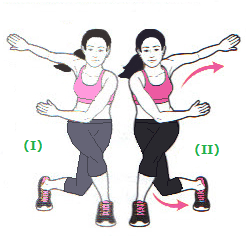All women want it: That shapely, sculpted, and defined butt we see in
the magazine ads for cellulite cream. Closets full of skinny jeans and
miniskirts have us focused more than ever on lifting, tightening, and
shaping our behinds.
But what many of us really want to know is this: Is there a butt workout that can actually help us get those round, lifted, and chiseled derrieres we covet?
It depends.
"If
you're a 45-year-old mother of two and you start doing glute exercises,
you're not going to look like a 20-year-old woman who's never had
kids," says Maryland-based fitness trainer, speaker and consultant
Jonathan Ross.
Fat cells the body has deposited around the hips
and thighs are less responsive than in other parts of the body, Ross
explains. "Progress is still possible. It just takes a lot of i dotting and t crossing when it comes to nutrition and exercise," he says.
Realistically, say experts, you can improve the strength and shape of your butt with diet and exercise. But if you're expecting to look just like that picture in the magazine, you may be disappointed.
The Butt Workout: Six Exercises for Glutes
Aerobically, walking hills is a great butt workout. Indoors, use a 5% to 7% incline grade on your treadmill, says Michele Olson, PhD, CSCS, exercise physiologist at Auburn University in Montgomery, Ala.Climbing stairs is another great choice for working the glutes. Find a stadium, or use a stair machine, elliptical, or arc trainer to help define the butt. For variety, dust off those inline skates and hit the pavement.
After working up a sweat aerobically, try these six butt-busting strength exercises recommended by our experts (aiming for three sets of 10 to 15 repetitions of each):
1. Squats. One of the best exercises you can do for your butt, hips, and thighs is the squat, say experts. Stand with feet parallel and shoulder-width apart. Slowly lower your hips, making sure not to let your knees go out past your toes.
Variations are endless. "I like plie squats to really work those deep rotator muscles," Olson says. To do them, stand with your feet wider than shoulder-width apart, legs turned out. When squatting, keep knees over ankles; press through the feet and squeeze the glutes as you come up to standing.
2. Lunges. Beginning with your feet parallel and hip-distance apart, take a giant step forward or backward. Slowly lower your body, bending both knees. Bend your knees no farther than 90 degrees, keeping your front knee aligned over your front ankle. Step together and repeat.
Alternate legs or do all sets on one leg and then switch for a greater challenge, says Olson: "You're cutting the rest time by half, and even though you do the same amount, your legs will be working harder."
Beginners should stay in the lunge and just lower and lift by bending the knees, she says.
Ross likes tweaking a forward lunge to really target the glutes: While lunging, reach both arms down toward the floor outside the front foot (hold a medicine ball or light dumbbell for added challenge). Durkin adds a hop to alternate feet for the advanced client.
3. Bridges. Lie on your back with knees bent and feet on the floor, hip-width apart. Slowly peel your spine off the floor from the bottom, one vertebra at a time, tightening the glutes and hamstrings (backs of the thighs) until you've created a diagonal line from your shoulders to your knees. Return to the floor slowly, one vertebra at a time.
Olson likes the one-legged bridge: Hold the knees tightly together and extend one leg at knee level while in the bridge position. Do all repetitions on one side, then switch.
To take it to the next level, try the bridge on a stability ball. With the head and tops of shoulders balanced on the ball, lift the hips into a tabletop position, level with the shoulders, then lower slightly and repeat.
Advancing from there, lift into the bridge position on the ball, then take two baby steps to your left, changing the line of gravity so you're off-center, then drop and lift the hips. "The left glute should work a bit harder than the right," Ross says. This move, he emphasizes, requires good core balance and takes only a very small shift (2-4 inches) in lower body position. Do all the repetitions on one side, then switch
.
4. Step-ups. Using a weights bench (a step would work, too), step one foot on top, then push through the top leg and glute to lift the bottom leg up and tap the bench. Lower and repeat using the same leg. Add hand weights or a knee lift with the tapping leg for a greater challenge, suggests Olson.
5. Leg/hip extensions. Reaching a leg behind your body is a great way to work the glutes. In Pilates, it's done while lying on your side, but you can also do it while lying over a stability ball or standing. Using a slow, controlled motion, extend the leg behind the body while squeezing the glutes and keeping the torso stable. Do three sets of 15 repetitions, then switch legs.
Up the ante with a single-leg dead lift, a Durkin favorite. While standing, extend one leg back and hinge from the hip. At the same time, lower the torso to parallel with the floor. Keep the abs tight and return to standing, lowering the back leg.
6. Skater plyos. Feeling like Drew Brees? Try this plyometric side step, a Durkin staple. Standing with feet under hips, take a lateral (sideways) hop to the left on your left foot while coming down to touch your right hand to the floor. Alternate sides and try to complete three sets of 20. Ouch! "This is great for strength, power, agility and toning up," says Durkin.












0 comments:
Post a Comment